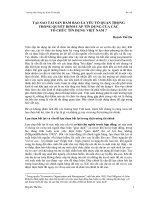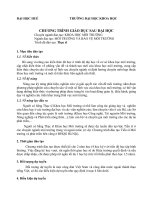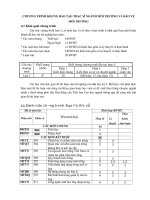Chương trình HyBeboloit
Bạn đang xem bản rút gọn của tài liệu. Xem và tải ngay bản đầy đủ của tài liệu tại đây (75.49 KB, 11 trang )
CHÖÔNG TRÌNH HYBEBOLOIT
a := 1
a.minimum := -2
a.maximum := 2
b := 1
b.minimum := -2
b.maximum := 2
c := 1
c.minimum := -2
c.maximum := 2
d := 1
d.minimum := -2
d.maximum := 2
graph3d.box := false
graph3d.mesh := true
graph3d.view := standard
graph3d.background := black
graph3d.perspective := true
graph3d.resolution := 21
graph3d.highlight := 0
graph3d.shading := 0
graph3d.contrast := 1/2
graph3d.transparency := 0
graph3d.color := byheight
graph3d.minimumx := -3
graph3d.maximumx := 3
graph3d.minimumy := -3
graph3d.maximumy := 3
graph3d.minimumz := -3
graph3d.maximumz := 3
graph3d(a*x^2+b*y^2+sin(c*time)=d*z^2)
HÖÔÙNG DAÅN VIEÂT CHÖÔNG TRÌNH CHO HÌNH CO NÍC
Dynamic Photorealistic Graphing (DPGraph) -- the world's most powerful
2D through 8D graphing software, optimized for the internet.
Version 2004.08.22. Visit www.dpgraph.com for the full documentation, or
click on Open and then Edit to examine the sample files for useful tips; this
online help is a summary. Copying DPGraph for unlicensed users is illegal.
DPGraph is a trademark of David Parker. Other company and products
names are trademarks or registered trademarks of their respective
companies. Copyright (C) 1997-2004 by David Parker. All rights reserved.
COMMON ERRORS: The seven most common mistakes when creating
graphs in the EDIT dialog box are: 1) leaving out asterisks for
multiplication; 2) leaving out equals signs or inequality signs; 3) leaving out
the parentheses for lists; 4) trying to use equalities in intersections (DPGraph
can only intersect inequalities, i.e. regions of space); 5) putting a space
inside the two-character symbols :=, >=, or <=; 6) using the parametric
variables u or v in implicit graphs; and 7) using the implicit variables x, y, z,
r, theta, rho, or phi in parametric graphs.
WRONG: RIGHT:
graph3d( 3x = z^2 ) graph3d( 3*x = z^2 )
graph3d( x^2+y^2 ) graph3d( z = x^2+y^2 )
graph3d( x=1, y=1 ) graph3d( ( x=1, y=1 ) )
graph3d( x=1 & y=1 ) graph3d( x>1 & y>=1 )
graph3d( z^2> =x^2 ) graph3d( z^2 >= x^2 )
graph3d( z=u^2+v^2 ) graph3d( z=x^2+y^2 )
graph3d( rectangular(x,y,sin(x+y)) ) graph3d( rectangular(u,v,sin(u+v)) )
INEQUALITIES: When graphing an inequality, such as GRAPH3D( X>1 ),
remember that "blue is true"; the bluest side of the graph is the region of
space for which the inequality is true, the reddest side of the graph is the
region of space for which the inequality is false. If the inequality is true for
the surface itself, as in GRAPH3D( X>=1 ), then the bluest side is pure blue;
if the inequality is false for the surface itself, as in GRAPH3D( X>1 ), then
the reddest side is pure red.
DEFAULTS.DPG: With experience you may find the following technique
useful when exploring a new surface. OPEN the file DEFAULTS.DPG, go
to EDIT, modify the default equation, and then EXECUTE. Since all of the
options are already in DEFAULTS.DPG they can be changed with very little
typing. If you like, SAVE the modified file under a different name and it
will be ready for future viewing and adjustments.
RESOLUTION: The easiest way to improve the appearance of some graphs
is to increase the resolution. The default resolution is 21 by 21 by 21 for
implicit graphs, and 40 by 40 for parametric surfaces. To change the
resolution for implicit graphs, use the EDIT dialog box to insert a line such
as the following before the GRAPH3D command:
graph3d.resolution := 30
For parametric surfaces:
graph3d.stepsu := 50
graph3d.stepsv := 50
You may find it useful to use the technique described in the previous section
on DEFAULTS.DPG.
COPYING A GRAPH TO THE CLIPBOARD: Click on CLIPBOARD to
copy a picture of the graph to the clipboard. To copy a picture of the entire
window (including the border, etc.) to the clipboard, simultaneously press
down the ALT and PRINTSCREEN keys. To copy a picture of the whole
screen to the clipboard, press PRINTSCREEN.
COPYING A GRAPH INTO ANOTHER APPLICATION: If the other
application supports pasting, first copy the graph to the clipboard. Then
click on EDIT in the other application, then click on PASTE.
PRINTING A GRAPH: First copy the the graph to an application, such as
Word or Paint, that supports printing. Then click on FILE in the other
application, then click on PRINT.
FILE FORMAT: DPGraph files have a file type of .DPG. There are two
kinds of DPG files: binary and ASCII. DPGraph can read and write either
type of DPG file, but the DPGraph Viewer can only read binary DPG files.
Binary DPG files are compressed and contain error detection information for
more reliable transmission. ASCII DPG files are readable and editable by
Notepad and many other text editors. Each line in the file is a separate
command for DPGraph. For example, a file might look like this:
graph3d.view:=top
graph3d.perspective:=false
graph3d(z=3*sin(x*y))
Each command must start on a separate line. The GRAPH3D command
must be the last command.
UNINSTALLATION: There are two ways to remove DPGraph from your
hard disk drive. Method 1: click on START - SETTINGS - CONTROL
PANEL - ADD/REMOVE PROGRAMS, then scroll to DPGraph in the
window, select it, and click on ADD/REMOVE. Method 2: click on
START - PROGRAMS - DPGRAPH - UNINSTALL.
OPTIONS: Non-numeric default values are given in capital letters.
graph3d.resolution (resolution along longest side of
box, default is 21; other sides of
box have a resolution proportional
to the length of the side)
graph3d.mesh (TRUE or false)
graph3d.perspective (TRUE or false)
graph3d.box (TRUE or false)
graph3d.view (STANDARD, top, side, front, or
textbook)
graph3d.contrast (default is 1/2, range is 0 to 1)
graph3d.transparency (default is 0, range is 0 to 1)
graph3d.background (black, gray, WHITE, brown, red,
yellow, green, cyan, blue, or magenta)
graph3d.color (BYHEIGHT, bysteepness, black,
gray, white, brown, red, yellow,
green, cyan, blue, magenta, or an
expression depending on x, y, z, or time)
graph3d.highlight (default is 0, range is 0 to 1)
graph3d.shading (default is 0, range is 0 to 1)
graph3d.vectorcolor (BYHEIGHT, bysteepness, black,
gray, white, brown, red, yellow,
green, cyan, blue, magenta, or an
expression depending on x, y, z, or time)
graph3d.vectorhighlight (default is 0, range is 0 to 1)
graph3d.vectorshading (default is 0, range is 0 to 1)
graph3d.vectoralign (TAIL, center, or tip)
graph3d.vectorarrowhead(true or FALSE)
graph3d.minimumx (default is -3)
graph3d.maximumx (default is 3)
graph3d.minimumy (default is -3)
graph3d.maximumy (default is 3)
graph3d.minimumz (default is -3)
graph3d.maximumz (default is 3)
graph3d.minimumu (default is -3)
graph3d.maximumu (default is 3)
graph3d.stepsu (default is 40)
graph3d.minimumv (default is -3)
graph3d.maximumv (default is 3)
graph3d.stepsv (default is 40)
a.minimum (scrollbar variable minimum value)
a.maximum (scrollbar variable maximum value)
b.minimum (scrollbar variable minimum value)
b.maximum (scrollbar variable maximum value)
c.minimum (scrollbar variable minimum value)
c.maximum (scrollbar variable maximum value)
d.minimum (scrollbar variable minimum value)
d.maximum (scrollbar variable maximum value)
VALUES FOR OPTIONS:
true (for mesh, perspective, box, and vectorarrowhead)
false (for mesh, perspective, box, and vectorarrowhead)
standard (for view, x is the most horizontal axis)
textbook (for view, y is the most horizontal axis)
top (for view)
front (for view)
side (for view)
byheight (for color or vectorcolor)
bysteepness (for color or vectorcolor)
black (for color, vectorcolor, or background)
gray (for color, vectorcolor, or background)
white (for color, vectorcolor, or background)
brown(for color, vectorcolor, or background)
red (for color, vectorcolor, or background)
yellow (for color, vectorcolor, or background)
green (for color, vectorcolor, or background)
cyan (for color, vectorcolor, or background)
blue (for color, vectorcolor, or background)
magenta (for color, vectorcolor, or background)
tail (for vectoralign)









